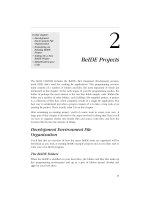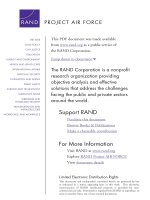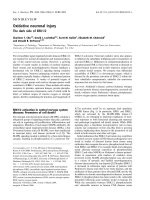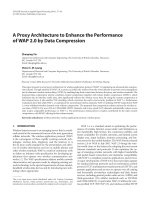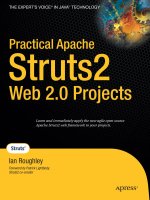the strategic plan of heeap 2.0 project
Bạn đang xem bản rút gọn của tài liệu. Xem và tải ngay bản đầy đủ của tài liệu tại đây (128.79 KB, 22 trang )
1
An Introduction to a
Strategic Planning Process
- Defining the Goals
and Metrics for
HEEAP 2.0 -
Summary of May 31, 2012
Workshop
2
Terminology I Use
•
To gain consensus:
What How
Long Term
Near Term
Goal Strategy
Program Action
Required
3
Initial Set of Six (6) Goals
Extracted from components found in
HEEAP 2.0 proposal
4
Goal 1: Leadership Development
•
Goal:
–
Training leaders in modern and innovative institutional models
that facilitate policy changes to meet requirements of national
economic development and international integration by 2018.
•
Metrics:
–
Number of Rectors / Vice Rectors / Deans trained = 100% (80 –
100 total trained)
–
At least 25 “large” international projects funded related to
leadership advancement
–
Many “large” domestic projects funded
5
Goal 2: Faculty Development
•
Goal:
–
For universities, training faculty in active teaching methodology,
curriculum development, and English skills reaching regional
standardization (e.g. AUN, …) or ABET/CDIO compliance
creating a research capacity.
–
For vocational colleges, the same faculty development but with
the focus on creating occupational skills
•
Metrics:
–
Up to 3000 faculty in universities and vocational colleges will be
trained by HEEAP 2.0
–
80% of lecturers use active teaching methods
–
Average IELTS score of 5.0 (or equivalent TOEFL scores) for all
1400 faculty at the universities
–
80% of Engineering Curriculum achieves ABET / CDIO
compliance.
6
Goal 3: Curriculum, Labs
and Infrastructure
•
Goal:
–
Establishing curriculum re-design and upgrading the infrastructure
in cooperation with industry in order to improve the training
quality that meets the demands of the high quality labor force.
•
Metrics:
–
100% of curriculum is re-designed for HEEAP schools
–
20% of HEEAP school budget comes from industry
–
100% of courses equipped with modern equipment.
7
Goal 4: Distance Education
•
Goal:
–
Facilitate the access of large numbers of students and solve the
large class issue by offering Distance Education supporting life
long learning while achieving scale economies.
•
Metrics:
–
At least one distributed education media-based networked
classroom in each university by 2014.
–
Offer distributed, on-line asynchronous course offerings at the
universities and vocational colleges within HEEAP 2.0 by 2018.
–
Scalable on-line course design to support 10% of courses.
–
E-learning system access across 80% of Vietnam
–
100% of lecturers and students at universities trained to use
system
8
Goal 5: Diversity and Instructional
Expert Development
•
Goal:
–
Increase the role and participation of women in technical and
engineering fields.
•
Metrics:
–
Achieve 10% female student population
–
Achieve 5% female faculty population by 2018.
–
Prepare females for university and vocational college leadership
positions.
9
Goal 6: English
•
Goal:
–
To be regionally and globally competitive by improving the
English proficiency of students and faculties in Engineering and
Applied Technologies.
•
Metrics:
–
For universities and vocational schools in HEEAP 2.0, by 2018 we
will have the following English certificates:
•
____% of students at universities we will have a TOEFL score of 500
•
____% of students at vocational colleges we have a TOEIC score of
350-400
–
____% of all Engineering and Applied Technology training
programs will be conducted in English
–
______ number of English-speaking exchange students and
faculty
10
Potentially Compressed Set of Goals
Recognition that must strategically
execute successfully for HEEAP 2.0
to be deemed a success.
11
The Strategic Magic Number
01–22–3
Goals
Achieved
With
Excellence
11–204–102–3
Number of
Goals
Goal Strategy
Program Task
With this strategic
planning structure.
12
Goal 1 Expanded:
Leadership Development
•
Goal:
–
Training leaders in modern and innovative institutional models that facilitate policy changes to
meet requirements of national economic development and international integration by 2018.
–
Increase the role and participation of women in technical and engineering fields.
–
To be regionally and globally competitive by improving the English proficiency of students and
faculties in Engineering and Applied Technologies.
•
Metrics:
–
Number of Rectors / Vice Rectors / Deans trained = 100% (80 – 100 total trained)
–
At least 25 “large” international projects funded related to leadership advancement
•
Many “large” domestic projects funded
–
Achieve 10% female student population and achieve 5% female faculty population by 2018.
–
Prepare females for university and vocational college leadership positions.
–
For universities and vocational schools in HEEAP 2.0, by 2018 we will have the following
English certificates:
•
____% of students at universities we will have a TOEFL score of 500
•
____% of students at vocational colleges we have a TOEIC score of 350-400
–
____% of all Engineering and Applied Technology training programs will be conducted in
English
–
______ number of English-speaking exchange students and faculty
13
Goal 2 Expanded:
Faculty Development
•
Goal:
–
For universities, training faculty in active teaching methodology,
curriculum development, and English skills reaching regional
standardization (e.g. AUN, …) or ABET/CDIO compliance
creating a research capacity.
–
For vocational colleges, the same faculty development but with
the focus on creating occupational skills
•
Metrics:
–
Up to 3000 faculty in universities and vocational colleges will be
trained by HEEAP 2.0
–
80% of lecturers use active teaching methods
–
Average IELTS score of 5.0 (or equivalent TOEFL scores) for all
1400 faculty at the universities
–
80% of Engineering Curriculum achieves ABET / CDIO
compliance.
14
Goal 3 Expanded: Curriculum, Labs
and Infrastructure
•
Goal:
–
Establishing curriculum re-design and upgrading the infrastructure in
cooperation with industry in order to improve the training quality that
meets the demands of the high quality labor force.
–
Facilitate the access of large numbers of students and solve the large class
issue by offering Distance Education supporting life long learning while
achieving scale economies.
•
Metrics:
–
100% of curriculum is re-designed for HEEAP schools
–
20% of HEEAP school budget comes from industry
–
100% of courses equipped with modern equipment.
–
At least one distributed education media-based networked classroom in each university by
2014.
–
Offer distributed, on-line asynchronous course offerings at the universities within HEEAP 2.0
by 2018.
–
Scalable on-line course design to support 10% of courses.
–
E-learning system access across 80% of Vietnam
–
100% of lecturers and students at universities trained to use system
15
Converting Barriers to Opportunities
We must attack each perceived
barrier and create a plan to overcome
the barrier in a timely manner.
16
Barriers for Goal 1:
Leadership Development
•
Please list the barriers
you can see for this
goal:
–
Overload
–
English
–
Policy and autonomy
–
Paperwork
–
Limitations reaching
international projects
•
Please strategize on
how these barriers can
be overcome:
–
Flexible planning
–
Reward policy
–
Renovation systems
–
Reorganize the
administrative systems
–
Improve the information
systems
17
Barriers for Goal 2:
Faculty Development
•
Please list the barriers
you can see for this
goal:
–
Overload
–
English
–
Big class sizes
–
Limited time for research
–
Lack of resources (time,
finances, facilities)
–
“Old fashioned” thinking\
–
Recruitment system
•
Please strategize on
how these barriers can
be overcome:
–
Good Planning
–
Training
–
Increased lecturers
–
Count on research
–
Increase investment
–
–
Training
–
Transparent policy
18
Barriers for Goal 3: Curric, Labs and
Infrastructure
•
Please list the barriers
you can see for this
goal:
–
Limited money
–
Conservative
–
Industry support limited
–
Out-of-date facilities
–
Labor market
–
Lecturers have limited
knowledge and skills
•
Please strategize on
how these barriers can
be overcome:
–
Government investment
–
Better policy
–
Government policy
–
Government investment
–
Flexible education system
–
Training
19
Barriers for Goal 4:
Distance Education
•
Please list the barriers
you can see for this
goal:
–
Policy and willingness
–
Infrastructure
–
E-lecture redesign
–
Lack of experience and
skills
–
Requirements of
supporting activities
–
•
Please strategize on
how these barriers can
be overcome:
–
Awareness and efforts of
leaders
–
Investment, fund raising
–
Training and encouraging
–
Training
–
–
Organizing system
20
Barriers for Goal 5: Diversity &
Instructional Expert Development
•
Please list the barriers
you can see for this
goal:
–
Social mentality
–
–
Physical of women’s body
–
Psychology of women
–
–
–
•
Please strategize on
how these barriers can
be overcome:
–
Policies from government
and universities
–
(nothing can do here)
–
Social awareness
–
–
–
21
Barriers for Goal 6: English
•
Please list the barriers
you can see for this
goal:
–
Lack of English
background in education
–
Lack of English
environment
–
Lack of quality and
quantity of English teachers
–
Lack of English teaching
materials
•
Please strategize on
how these barriers can
be overcome:
–
Policy of English
enhancement in schools
–
More international
exchanges
–
Training
–
–
Material upgrading
–
22
Fundamental Question
•
We have developed common Goals for all
HEEAP 2.0 participants
•
How should we proceed:
–
A: Assume universities and vocational
colleges will pursue common Strategies?
–
B: Assume universities will pursue common
Strategies and vocational colleges will pursue
common Strategies?
–
C: Assume universities and vocational
colleges will pursue unique Strategies?
